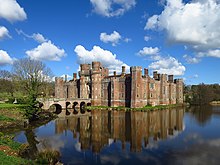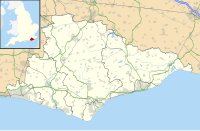Hurstmonceaux Castle
| Herstmonceux Castle | |
|---|---|
| East Sussex, England | |

Herstmonceux Castle, seen from the south-east
|
|
| Coordinates | 50°52′10″N 0°20′19″E / 50.8695°N 0.3387°ECoordinates: 50°52′10″N 0°20′19″E / 50.8695°N 0.3387°E |
| Grid reference | grid reference TQ64511046 |
| Type | Tudor mansion |
| Site information | |
| Owner | Queen's University, Canada |
| Condition | Intact, used as a study centre |
| Site history | |
| Materials | Brick |
Herstmonceux Castle is a brick-built castle, dating from the 15th century, near Herstmonceux, East Sussex, England. From 1957 to 1988 its grounds were the home of the Royal Observatory, Greenwich. Today it is used by the Bader International Study Centre of Queen's University, Canada.
Herstmonceux Castle is one of the oldest significant brick buildings still standing in England. The castle was renowned for being one of the first buildings to use that material in England, and was built using bricks taken from the local clay, by builders from Flanders. It dates from 1441. Construction began under the then-owner, Sir Roger Fiennes and then, from his death in 1449, by his son, Lord Dacre. The emphasis is on grandeur and comfort instead of defence.
Herstmonceux Castle is home to events throughout the year, including the annual England's Medieval Festival on August Bank Holiday weekend.
The parks and gardens of Herstmonceux Castle and Place are Grade II* listed on the Register of Historic Parks and Gardens. Other listed structures on the Herstmonceux estate include the Grade II listed walled garden to the north of the castle, and the Grade II* listed telescopes and workshops of the Herstmonceux Science Centre.
The first written evidence of the existence of the Herst settlement appears in William the Conqueror's Domesday Book which reports that one of William's closest supporters granted tenancy of the manor at Herst to a man named ‘Wilbert'. By the end of the twelfth century, the family at the manor house at Herst had considerable status. Written accounts mention a lady called Idonea de Herst, who married a Norman nobleman named Ingelram de Monceux. Around this time, the manor began to be called the “Herst of the Monceux”, a name that eventually became Herstmonceux.
...
Wikipedia

